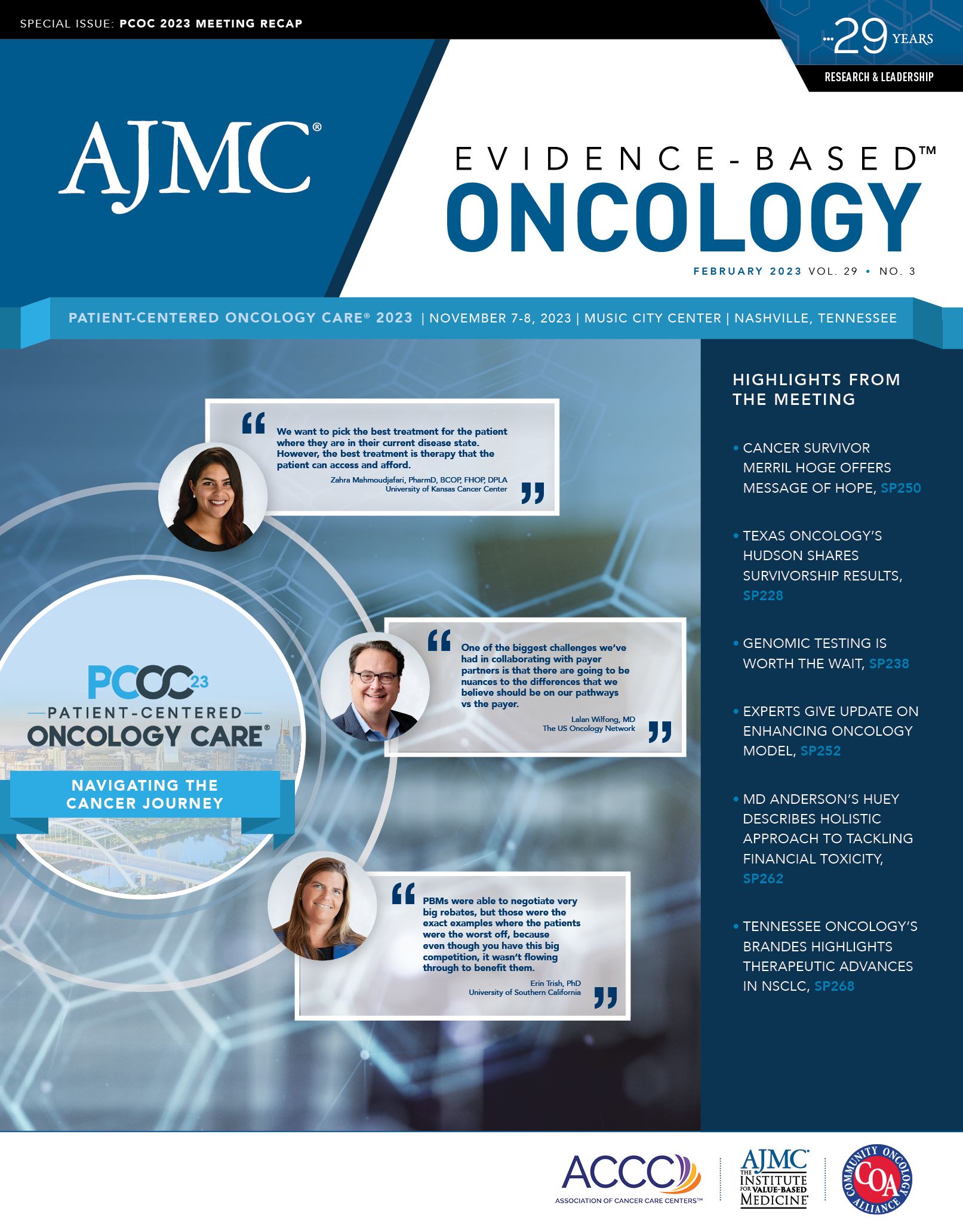- Center on Health Equity & Access
- Clinical
- Health Care Cost
- Health Care Delivery
- Insurance
- Policy
- Technology
- Value-Based Care
In Cancer Care, Building Trust Requires Understanding, Meeting Patients Where They Are
Ongoing engagement with patients is paramount to ensuring that treatment recommendations are well understood and adhered to, as well as making sure patients trust their provider and share in care decisions. But increasing patient engagement and building trust in communities with a history of inequality and subpar treatment can be difficult, as a panel of experts at Patient-Centered Oncology Care 2023 conference discussed.
In a session titled “Building Trust: Tools and Strategies for Patient Engagement,” a panel moderated by Mary Caffrey, executive editor for The American Journal of Managed Care and Evidence-Based Oncology, discussed the need to improve patient engagement in health care and ways providers can foster engagement for better care quality.
The panel included Susan Sabo-Wagner, MSN, RN, OCN, NEA-BC, vice president of clinical innovation at American Oncology Network in Cypress, Texas; Samyukta Mullangi, MD, MBA, medical oncologist at Tennessee Oncology and medical director of Thyme Care in Nashville, Tennessee; and Mayra Serrano, DrPH, MPH, CHES, health equity director at Anthem Blue Cross of California.
Samyukta Mullangi, MD, MBA | Image: Tennessee Oncology

In an introductory talk, Mullangi emphasized that patient engagement is increasingly important to health care organizations, with evidence showing it can improve treatment adherence to treatment recommendations and clinical protocols.
“Access to health care information and technology has advanced to such a point that patients are much more aware of their care conditions and options than ever before,” Mullangi said. “And while medicine may previously have operated under somewhat of a paternalistic framework, I’d say that today’s patients are so much more well informed and motivated to be involved in their own medical care. And it’s a means of ensuring that patients are provided with the right care appropriate to their individual characteristics, needs, preferences, and conditions.”
A model for patient engagement must include all stakeholders, Mullangi explained, including health care organizations, payers, providers, and patients and their families. Highly engaged patients are more likely to perform behaviors to improve their health and participate in preventive care, Mullangi noted. Still, there is much work to be done in the realm of improving patient engagement in the US health care system, which is often fragmented and not personalized to patients.
Mullangi noted the difficulty of tackling this issue. In cancer care, even the most self-educated and engaged patients will be inundated with complex medical information and treatment options on the web that can confuse matters from their perspective. Investing in technology to help engage patients is important, but ensuring that patients actually engage with such tools and tailoring these tools to patient needs is key. These technology solutions must also account for levels of access—for example, using methods such as telephone calls rather than web-based portals in areas where many patients do not have broadband access.
Solutions such as the collection of electronic patient-reported outcomes must also vary from patient to patient because patients on different treatment regimens or in different age or demographic groups will have distinct experiences and concerns, Mullangi said.
Addressing Historic Mistreatment and Listening to Patients Is Key to Building Trust
Building trust between providers and patients can be a challenge, particularly among ethnic, racial, sexual, and gender minority groups who have historically faced mistreatment by the health care system, Serrano explained. She noted that events such as the infamously inhumane Tuskegee Syphilis Study, which was initiated in 1923 and spanned 40 years, have led to an atmosphere of mistrust of medical providers. In the study, 600 Black men, 399 of whom had syphilis and 201 who did not, were not treated properly even as standards of care advanced, and participants were not informed of the study or its purpose.1
While processes such as informed consent were created to prevent such an incident from happening again, historical treatment cannot be ignored.
Mayra Serrano, DrPH, MPH, CHES | Image: LinkedIn

Susan Sabo-Wagner, MSN, RN, OCN, NEA-BC

“One of the most important things we have to do is not just talk about mistreatment and mistrust as something that used to happen, but also address the fact that it’s something that happens now—that we have some systems where there is systemic racism and there is systemic discrimination for folks—and actually listen to people,” Serrano said. Listening to patients when they share concerns or recount instances of microaggressions and taking these situations seriously is crucial.
Lived experience is a big piece of the puzzle, and Serrano noted the importance of seeking out input from patients with experience in these spaces. Ensuring that there is diverse representation among providers, researchers, and recruiters is also important to cater to a diversity of patients, Serrano said. When there is racial and cultural concordance between patients and care teams or researchers, it can be easier to build trust.
Sabo-Wagner agreed with Serrano, adding that education is key and validating patients’ concerns is another way to improve their trust in providers and the health care system.
“It’s really critical to validate those concerns. Patients are going to come in who have a history of different types of trust, and different populations have a different type of trust for very different reasons. It’s validating those concerns, understanding that it’s real, and the training of staff and teams and making sure those things are done annually or twice a year or on orientation and beyond,” Sabo-Wagner said. She echoed Serrano’s emphasis on the importance of diverse representation among care teams and employees at health care centers, including regarding languages spoken by the community a center serves.
Serrano also addressed the importance of embracing cultural humility in diversity, equity, and inclusion trainings and when exploring ways to improve the experiences of patients across cultures. Cultural humility differs from cultural competence, she said, because it is an approach that assumes there is always more to learn vs insinuating that competence can be achieved and is enough to solve the problems discussed by the panel and more.
How Can Payers Help Build Trust Across Populations?
It takes time and effort to figure what, exactly, is needed to improve patients’ engagement and foster an atmosphere of trust in health care, Serrano explained. While providers and clinicians may not have the time, payers may be able to dedicate resources to find out more about patient sentiments in the locales they cover. For example, Serrano did a listening tour to speak with providers and members to learn about the system—an undertaking that she noted was well worth the time it took.
Regarding tools for patient engagement, Sabo-Wagner stressed the importance of meeting the patient where they are. Proper care for a patient includes not just medical treatment, but also solutions to issues such as transportation, child care, and financial resources, she said, and care navigation from population health through specialty care and end-of-life care is the ideal. Communicating with patients and identifying services they may need before they need them is important, and that includes addressing language barriers and resource barriers.
Mullangi noted that technology can be helpful in keeping patients connected with physicians. One opportunity for technological intervention is aftercare, which is an important part of ensuring patients do not experience further exacerbations after acute care visits and that patients are not left with questions or confusion about the measures they should be taking to manage chronic and acute conditions.
“Continuous engagement with patients between visits is a way to engender that sort of trust and patient engagement,” Mullangi said, explaining that through Thyme Care, a team completely separate from practices engages with patients 2.5 to 3 times per month and helps keep patients engaged. These encounters, which are customized to patients’ needs, offer opportunities to remind patients what proper care looks like. Mullangi noted that virtual care has been a promising development to increase care access and that telehealth can take different forms depending on patient needs. She shared data from an abstract that had just been presented during the American Society of Clinical Oncology Quality Care Symposium, which found that Thyme Care’s patient navigation approach reduced total of cost of care by $594 per patient per month relative to control participants.2
Circling back to the concept of meeting patients where they are, Serrano noted that assessing and addressing patients’ social needs is another way to build trust. This strategy is key to treating the whole patient, not only the conditions a patient presents with. Identifying what barriers may contribute to nonadherence to treatment is also important, Serrano said.
Clinical trials represent another area of opportunities to engage patients, Sabo-Wagner explained. To expand the reach of trials, she noted the importance of starting in the community and making sure patients in this setting understand that trials are available and that participation in a trial is safe. In this vein, Serrano recounted her dissertation, which was about a community health worker model to increase Latino participation in clinical trials via community champions who are not health care workers, but trusted community champions.
No matter the strategy, all panelists agreed on the importance of engaging with patients and building trust on an ongoing basis. Recurring efforts to keep patients informed and engaged are key to improving the patient experience and building upon progress made thus far in fostering trust between providers and patients.
Sabo-Wagner closed the session with a reminder that no matter the approach, care must be individualized, and despite the existence of predictive tools for patient needs, technology cannot replace the value of a human speaking to another human.
“I think we’ll always need the human piece to it, and I would never want to be a patient without the human piece to it,” Sabo-Wanger said. “Communication will always be the No. 1 tool that we can use to build trust with our patients.”
References
1. About the USPHS syphilis study. Tuskegee University. Accessed January 29, 2024. https://www.tuskegee.edu/about-us/centers-of-excellence/bioethics-center/about-the-usphs-syphilis-study
2. Mullangi S, Worland S, Hill B, et al. Association of patient navigation with health care spending among Medicare Advantage members: a difference in differences analysis. Presented at: ASCO Quality Care Symposium; October 27-28, 2023; Boston, MA. Abstract 557. https://bit.ly/3OoK9Kl

